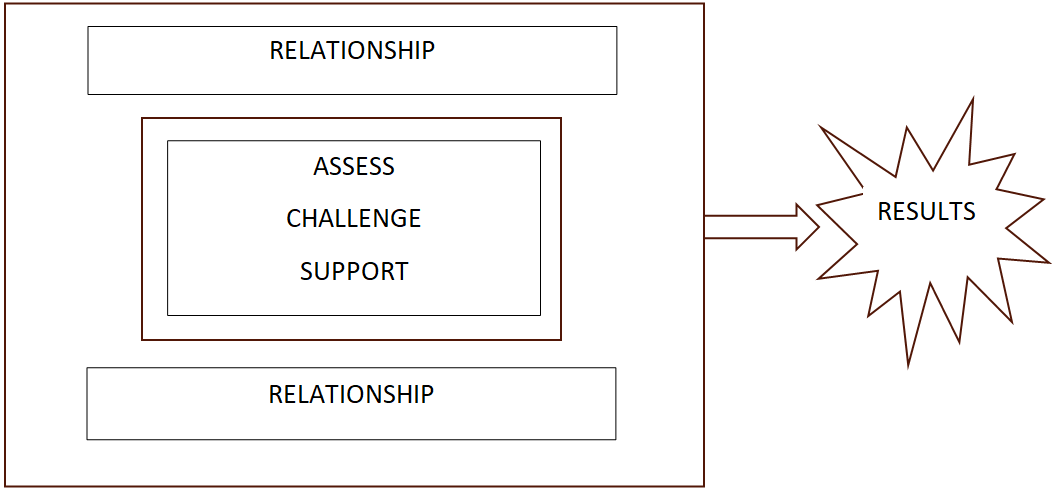A Coaching Model Created by The Centre for Creative Leadership
Article by Helen Ameyde
(Business Coach, BELGIUM)
Introduction
The RACSR coaching model is fundamentally one that is built around the results of three assessments – Workplace Big 5, FIRO – Business, and feedback from Benchmarks 360, Leading Managers.
I use the RACSR model as part of leadership coaching and a visual representation is below. In order to get results for the client (ICF Competency 10 – 11), the integrated coaching session takes place within a strong relationship: good rapport, following ethical guidelines, built on trust, and within boundaries set by thorough contracting (ICF Competencies 1 – 4). The assessments are used as an access point to good dialogue (ICF Competency 5), the challenge (ICF Competency 6 – 7), and support (ICF Competency 8 – 9) are open, honest, and linked to client goals and underpinned by active listening for understanding.
The RACSR Coaching Model

RACSR Integrated Coaching Process
Introduction to the coaching session:
Ensure the following are communicated to the client:
Establishing Rapport:
Questions are used to establish rapport and build trust and knowledge about the coaching process.
The coach is there to help the client develop what they do and how they do it. Firstly, the coach can look at what the leader needs to do i.e. the key leadership challenges that the client brings into the room – the technical problems that need solving in a team or organization i.e. the logic/head problems. Secondly, the coach can look at how the leader would like to develop – the adaptive challenges – the pathos/heart problems often concerned with intra and interpersonal relationships. The following questions start to frame that conversation.
What
How
Interpretation of Instruments:
When working with a client in an integrated coaching session, it is important to ascertain the client’s knowledge, know-how, and experience in relation to the three assessment tools by asking the simple question – what is your knowledge of the instruments?
Although the client will have had some content input concerning the three instruments during the leadership development program, it is important to clarify understanding and answer any questions the client has. The following is a broad outline of the three assessments and links that are referenced in the bibliography.
WorkPlace Big Five Profile (WPB5)
The WorkPlace Big Five Profile reveals an individual’s five personality super traits and 23 subtraits that explain work-related behaviors found in day-to-day encounters with co-workers, employees, managers, and colleagues. The WPB5 assessment is often referred to as a ‘measure of energy along 5 dimensions of personality’ (Paradigm Personality).

Firo Business
The FIRO-Business (Fundamental Interpersonal Relations Orientation – Business) instrument helps individuals understand their need for inclusion, control, and affection and how it can shape their behavior and interactions with others at work.
The results focus on 5 key interpersonal elements of leadership:
Benchmarks 360 – Leading Managers
The Leading Managers 360 provides 360-degree feedback to the client on 15 leadership competencies that have been identified as important to leadership effectiveness for mid- and senior-level leaders, as well as feedback on 5 areas that can potentially stall leaders’ careers.
Integration of Data
The integration of data is an important piece of the integrated coaching session and the data can help frame the conversation. It is important to get the client’s view on what the data is saying – it is only data – and the truth behind it lies within the client. Some questions that can start the discussion are:
Development planning and next steps:
It is important for the client to leave the session with a plan of action; to establish the next steps in relation to the key leadership challenges, personal development, and/or more information. The integrated session is followed by 2 x 1-hour virtual sessions where the client/coach can check into the goals set within the integrated session.
This process is a fundamental part of the RACSR method and ensures there is momentum underpinning the goals for the client and the sponsoring organization.
References
Center for Creative Leadership – RACSR framework – https://www.ccl.org/articles/leading-effectively-articles/coaching-1-idea-3-facts-5-tips/
Center for Creative Leadership – 360 Benchmarkshttps://www.ccl.org/lead-it-yourself-solutions/benchmarks-360-assessment-suite/
Firo B – https://www.themyersbriggs.com/en-US/Products-and-Services/FIRO
WorkPlace Big Five – https://paradigmpersonality.com/products/workplace-big-five-profile/